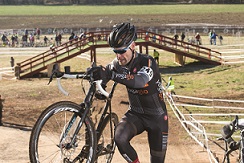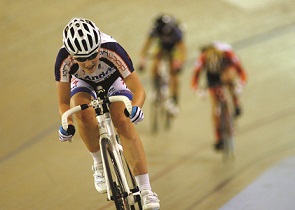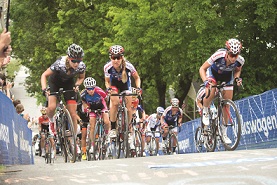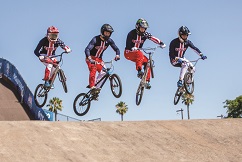

Building on the Success of the Olympics
It’s very normal for the sport to get a bump in traffic following the Olympics, and for people to become interested in becoming involved in the sport – particularly when Team USA did so well. Something we’ve noticed, though, is that the renewed interest doesn’t always translate into an increase in membership. It does, however, get more people into cycling and that’s always good.
People who want to get into cycling can go in a lot of different directions, and we try to help them find the ones that are right for them. When we see kids getting involved, we’ll often steer them over to our partners at USA BMX – a lot of the skills in cycling transfer to that discipline, and BMX is great for kids because it’s a very fun, family-friendly sport. Another great place for kids, particularly when they’re high school age, is the National Interscholastic Cycling Association (NICA), which offers mountain biking programs for student athletes.

Learning to Race Safely
For people who want to get into road racing, but who might be intimidated about just going out and doing it, USA Cycling has developed the Beginning Racer program. It is a series of five clinics that gets people comfortable with racing. Each day focuses on something different, from how to ride in a group to cornering safely to sprinting. We want to prepare people as much as possible for the actual experience of being in a race. On the fifth day, we have a mock race, then a debriefing session to go over everything. We’ve found that it is a really good, really low-pressure way to get people involved in the sport.
Gran Fondos are another fun way to help people immerse themselves in the racing scene. These are group rides with a mass start, a few timed segments people can do if they want to challenge themselves, a few low pressure hill climbs – and of course the ability to just ride with their friends. USA Cycling is working to partner with events like the Gran Fondo New York. By having a presence there, we can reach people who might want to continue to be involved in the sport.

Obviously, we want to keep increasing the number of people involved in the sport, but one particular focus is on women. It’s really an underrepresented demographic. Unfortunately, we haven’t really had any superstars in women’s cycling, and there really isn’t as much international attention for women in this sport. Men’s cycling has the Tour de France, which really gets a lot of people watching – but there isn’t an equivalent event for women. We are also missing those heroes and role models in the female space. At USA Cycling, we’re working to change that by focusing a lot of effort on our female athletes at the elite level.
We’re also working to make the sport youth-friendly. I know that many clubs encourage children to participate in their events; here in Colorado, one club allows them to register and ride free all summer long.
Keeping the Sport Clean
It’s no secret that cycling has had kind of a checkered past in terms of seeing people reach the pinnacle of the sport and then later turn out to be doping. Unfortunately, it has created some skepticism about the sport as a whole.
To combat this problem, we started our RaceClean program in 2013 and this year, we expanded it dramatically. A significant amount of membership fees go toward the program, which funds anti-doping tests at both the elite and the amateur levels of cycling. I think the RaceClean program alone has actually helped a lot with the perception problems the sport has suffered from. The fact that we have been very active in doing testing at the amateur level means that we have the opportunity to keep people away from even getting started doping. It’s a program we’re very proud of, and we’re looking forward to continuing it.

Here at USA Cycling, we’re always trying to offer new membership products. For example, we now have what we call our Ride Membership which includes a lot of benefits, but at a cost significantly less than what you would pay if you were actively racing.
In fact, we started the membership because we knew there were a lot of people out there riding their bicycles for fun and fitness, but they didn’t join because we didn’t have anything to offer people who didn’t race. Now we are actually able to offer something to that huge bucket of people out there who want to be a part of the fabric of American cycling. It includes a lot of great things – 24/7 cycling roadside assistance, a trial one-day membership for races or events, a subscription to our magazine and a lot more.
Challenges Facing the Sport
Cycling as a sport has a number of challenges facing it in the United States, particularly regarding the awareness of it as a sport. Unlike many sports in our popular lexicon, there is not a clear path to professionalism and many people are unaware that there is scholarship money available for people who want to compete in cycling at the collegiate level.
Presently, the sport is flourishing in the U.S., but sales of bicycles are down and participation in racing is on a plateau. USA Cycling really wants to work to raise the visibility of the sport and its potential, but it is going to be a while until we see it be as popular here as it is in other countries around the world. The fact that many countries rely much more heavily on bicycles for transportation is another way the sport stays in the forefront of those people’s minds.
Great Britain is a very good example of a place that has invested in the sport; in fact, they have made a very conscious effort and put a lot of resources into it and as a result, they have become dominant in cycling on the world level. (We’ve done the same thing with swimming.)
 Finding Sites for Championships
Finding Sites for Championships
The only events that USA Cycling owns and organizes at the national level are our national championships. As a result, those are the only events we need to find locations for. When we look for those sites, of course, we’re looking at the venues, and we’re also looking at airports and hotels and all the things people will need; in that sense, we’re like many sports that need to find the right host city.
Outside of that, though, we’re looking for municipalities that care about cycling as much as we do. We want to find cities that will put resources behind our championships, and where people in the area love cycling as a sport and will welcome the athletes and be spectators and volunteers. We need places with member clubs that are willing to support and promote the event, and that can help us find any resources we need. For a long time, we kept coming back to Bend, Oregon, for example, because it had everything we wanted.
A city that is supportive of cycling will not only be a great place to host an event but it becomes a great place to build the pyramid of cycling as a whole.

